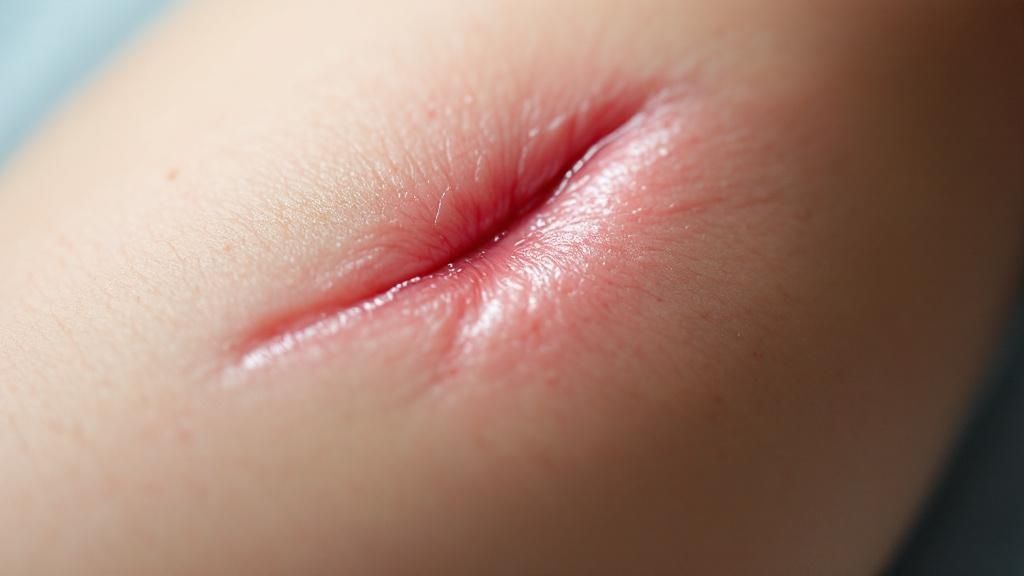Understanding Your Healing Journey (And What's Actually Happening)
After surgery, your body begins a complex process to heal your incision. This journey, from initial inflammation to complete tissue regeneration, involves a series of biological events. Understanding these stages helps you take an active role in your recovery and manage expectations.
The Initial Inflammatory Phase
Immediately after surgery, your body starts an inflammatory response. This is a normal part of healing. This stage involves swelling, redness, and warmth around the incision. It's like your body sending first responders to an injury. White blood cells and other healing factors arrive to repair damaged tissue. You might be interested in: Our knowledge base.
The Proliferative Phase
After the initial inflammation, the proliferative phase starts. This stage focuses on rebuilding new tissue. New blood vessels develop, delivering oxygen and nutrients to the healing wound. Specialized cells called fibroblasts produce collagen, a protein that strengthens the new tissue. This phase is essential for wound closure and building a strong foundation for healing.
The Maturation and Remodeling Phase
The final stage, maturation and remodeling, can last for months or even years. The new tissue gradually gains strength and flexibility. The collagen fibers reorganize, making the scar less noticeable and more resilient. The scar might not disappear completely, but it will fade and blend with the surrounding skin.
Variations in Healing
Everyone heals at their own pace. Factors like age, overall health, surgical technique, and incision size and location affect healing time. Larger or deeper incisions usually take longer to heal. Proper care of surgical incisions is also vital for post-operative recovery, impacting patient well-being and healthcare costs. Surgical site infections (SSIs) are a serious concern, potentially increasing hospital stays and expenses. Managing SSIs is a global challenge, with a 30-day cumulative incidence of roughly 11% across various surgical sites. Learn more about incision care and infection rates. Understanding the potential risks and taking proper precautions is critical for a successful recovery. By learning how to care for your surgical incision, you can minimize complication risks and support your body’s natural healing ability.
Daily Care That Actually Works (No Guesswork Required)
Forgetting complex post-operative routines is easier than you think. We'll break down daily surgical incision care, concentrating on what genuinely helps you heal. This advice comes straight from wound care experts and patients who've been through recovery themselves.
Gentle Cleaning: Less Is More
Cleaning your incision prevents infection while protecting delicate healing tissue. Use the gentle techniques recommended by experts. Often, simply washing the area with mild soap and water in the shower is enough. Avoid harsh chemicals like hydrogen peroxide or rubbing alcohol, as these can interfere with healing. This minimalist approach reduces irritation and promotes healthy tissue growth.
Dressing Changes: Timing and Technique
Knowing when and how to change your dressing is crucial. Your doctor will give you specific instructions, but dressings are usually changed when soiled or as directed. Use clean hands or sterile gloves when changing dressings. Never pull or tug on the dressing or the incision. For more in-depth guidance, see our resource on how to heal deep wounds faster. Careful handling ensures proper healing and minimizes infection risk.
To help you stay on track, we've created a handy guide for daily incision care:
Daily Incision Care Schedule: A detailed timeline showing when and how to perform each care activity throughout your recovery
| Time Period | Care Activity | Frequency | Key Points |
|---|---|---|---|
| After Showering | Gently clean incision with mild soap and water | Daily | Pat dry with a clean towel. Avoid rubbing. |
| As Needed or As Directed by Doctor | Change dressing | Varies | Use clean hands or sterile gloves. Don't pull on the incision. |
| Daily | Inspect incision for signs of infection | Once per day | Look for redness, swelling, increased pain, or pus. |
| Before Bed | Ensure incision is clean and dry | Nightly | Apply clean dressing if needed. |
This schedule provides a general framework. Always follow your doctor's specific instructions. Keeping a consistent routine helps minimize complications and supports optimal healing.
Showering and Bathing: Finding the Right Balance
Getting back to your regular hygiene routine feels good, but it's important to be careful. Showering is usually fine the day after surgery, but avoid soaking the incision in a bath or swimming pool for at least one to two weeks. Keeping the incision dry during the initial healing phase helps promote recovery. This means steering clear of activities that submerge the incision until your doctor says it's okay.
Maintaining Moisture Balance: The Goldilocks Principle
Proper moisture is essential. Too much moisture can lead to bacterial growth, while too little can dry out the wound and slow things down. It's all about finding the right balance. The right dressings can help maintain an ideal healing environment.
Sleeping Positions: Comfort and Healing
Getting comfortable after surgery can be difficult, especially if your incision is in a sensitive spot. Try not to put direct pressure on the incision. Using pillows for support can often help. Experimenting with different sleeping positions will help you find what works best. This ensures you get enough rest without affecting your recovery.
Choosing Products That Actually Help (Not Marketing Hype)
Walking down the wound care aisle can be a dizzying experience. So many products boast amazing healing, but how can you tell which ones live up to the hype? This section helps you cut through the marketing jargon and find the dressings and materials that truly promote surgical incision healing. We'll give you the knowledge to make smart decisions, not just fall for flashy advertising.
Matching Products to Your Needs
Finding the right wound care product comes down to your individual situation. A simple adhesive bandage might be perfect for a relatively dry, uncomplicated incision. But for incisions with more drainage, located on areas that experience a lot of friction, or on sensitive skin, you'll likely need something more advanced. This means carefully considering your incision's characteristics before buying anything. Check out this helpful resource: Effective Post-Discharge Wound Care at Home.
Decoding Dressing Types
Here's a rundown of the most common types of surgical dressings:
- Adhesive Bandages: Best for minor incisions with minimal drainage, these offer basic protection and are easy to change.
- Hydrocolloid Dressings: These dressings create a moist environment that speeds up healing and reduces friction. They're a great choice for incisions with moderate drainage.
- Foam Dressings: If you have an incision with heavy drainage, foam dressings are ideal, as they're highly absorbent. They also provide cushioning and insulation.
- Gauze Dressings: These versatile dressings can be used for a variety of purposes, including cleaning, packing, and covering incisions. They're available in many forms, from simple pads to rolls.
Having this variety means there's a suitable dressing for every unique situation.
To help you choose, here's a quick comparison:
Surgical Dressing Types Comparison: Comprehensive comparison of different dressing materials, their benefits, and ideal use cases
| Dressing Type | Best For | Pros | Cons | Cost Range |
|---|---|---|---|---|
| Adhesive Bandages | Minor, dry incisions | Easy to use, inexpensive | Not for heavy drainage | Low |
| Hydrocolloid Dressings | Moderate drainage, friction-prone areas | Promotes moist healing, protects from friction | Can be difficult to remove | Moderate |
| Foam Dressings | Heavy drainage | Highly absorbent, cushions and insulates | May not be suitable for dry incisions | Moderate to High |
| Gauze Dressings | Versatile use (cleaning, packing, covering) | Widely available, adaptable | Can stick to the wound | Low |
As you can see, each dressing type has its strengths and weaknesses, making it crucial to pick the right one for your needs.
Cost-Effective Alternatives
Many affordable alternatives work just as well as expensive name brands. Store-brand adhesive bandages, for example, often provide the same level of protection as name brands at a fraction of the cost. Generic gauze dressings are another budget-friendly option for basic wound care. Smart shopping can help you save money without compromising your recovery. Making your own saline solution, for example, instead of buying costly wound cleansers can really add up. This allows you to prioritize healing without breaking the bank.
Considering Advanced Options
While budget-friendly options are often sufficient, some high-end products offer significant benefits. Alginate dressings, for example, are incredibly absorbent and can accelerate healing in complex wounds. Silver-impregnated dressings offer antimicrobial properties, making them a good choice for incisions at higher risk of infection. The global surgical wound care market is growing rapidly, fueled by advancements in medical technology and a greater focus on patient recovery. In 2023, the market was valued at about USD 6.12 billion, and it's expected to surpass USD 9.87 billion by 2033, with a Compound Annual Growth Rate (CAGR) of 4.90%. This expansion highlights the rising demand for effective wound care solutions and the importance of reducing surgical site infections. Learn more about these market trends here. Understanding this growing market emphasizes the importance of finding the best products for your particular situation. Ultimately, talk to your healthcare provider. They can evaluate your individual needs and suggest the most suitable products to support your healing journey.

Spotting Problems Before They Become Serious
Knowing how to care for your surgical incision is crucial. Equally important is recognizing when something isn't right. While no one wants to constantly bother their doctor, ignoring genuine warning signs can have serious consequences. This section will help you confidently differentiate between normal healing and potential complications.
Recognizing Normal Healing
Understanding the typical healing process empowers you to monitor your incision effectively. Initially, some redness, swelling, and warmth around the incision are normal signs of inflammation. You might also experience some clear or slightly reddish drainage. These are positive indicators that your body is working to repair the tissue. It's your body's natural defense mechanism in action.
Identifying Red Flags
While some inflammation is expected, excessive or worsening symptoms could indicate a problem. Look out for increasing pain, significant swelling, and redness that spreads beyond the incision site. Thick, cloudy, or foul-smelling drainage (pus) is another warning sign. If you notice any of these, contact your healthcare provider promptly.
Signs of Infection
Infection is a serious complication that requires immediate medical attention. Along with the signs mentioned above, a fever, chills, or general malaise could signal an infection. Early detection and treatment are vital to prevent further complications. Read also: How Home Wound Care Speeds Up Recovery. Prompt action is your best defense against the infection spreading.
Other Potential Complications
Besides infection, other potential problems can arise. Wound dehiscence, the separation of the incision edges, can occur, especially with strenuous activity or improper wound care. Hematoma, a collection of blood outside of blood vessels, can also develop, causing swelling and bruising. If you notice any unusual changes in your incision, don't hesitate to seek professional advice.
Prevention is Key
Beyond recognizing warning signs, actively preventing complications is essential. Proper hand hygiene before touching your incision is paramount. Keep the incision clean and dry, and follow your doctor's instructions regarding dressing changes and showering. You might be interested in: How to Master….
Additionally, maintaining a healthy lifestyle supports healing. A balanced diet, adequate rest, and managing stress all contribute to a stronger immune system and faster recovery. This approach optimizes your body's natural healing abilities. Access to proper surgical care and resources also plays a significant role in preventing complications. Despite advancements in wound care, access remains a global issue. Approximately five billion people, or two-thirds of the world's population, particularly in low- and middle-income countries, lack access to essential surgical services. This disparity affects not only incision care but also the overall healthcare system. Explore this topic further here.
When to Seek Professional Help
Knowing when to contact your healthcare provider is crucial. While minor concerns can often be addressed with home care, certain situations warrant professional attention. If you're unsure whether a symptom is normal or a cause for concern, err on the side of caution and contact your doctor. Early intervention can prevent minor issues from becoming major problems. This proactive approach ensures the best possible outcome for your recovery. By understanding how to care for surgical incisions and recognizing potential complications, you empower yourself to actively participate in your healing journey.

Living Your Life While You Heal (Yes, It's Possible)
Recovery from surgery doesn't mean putting your life on hold. It's about striking a balance between rest and gradually returning to your normal routine while supporting your body's natural healing. This involves understanding how daily choices, from what you eat to how you manage stress, can significantly affect your surgical incision care.
Nutrition: Fueling Your Recovery
What you eat plays a vital role in how quickly your body repairs itself. A nutrient-rich diet packed with protein, vitamins, and minerals is key. Think of it as giving your body the essential building blocks it needs for tissue repair.
Protein, for example, is crucial for building new cells and collagen, the structural protein that strengthens healing wounds. Foods rich in vitamin C, such as citrus fruits and berries, also aid in collagen production. Zinc, found in foods like nuts and seeds, supports immune function and wound healing. This approach is not about restrictive diets, but about nourishing your body for optimal recovery.
Activity Levels: Balancing Rest and Movement
Rest is essential, particularly in the initial recovery phase. However, gentle movement is equally important. It promotes blood circulation, prevents complications like blood clots, and boosts overall well-being.
Short walks, for example, can improve circulation and help prevent stiffness. As your incision heals, gradually increase your activity level based on your doctor's advice. This phased approach allows your body to adapt and minimizes the risk of setbacks.
Exercise: Supporting, Not Straining
While gentle movement is beneficial, avoid strenuous activities or exercises that put direct pressure on your incision. Initially, avoid lifting heavy objects, as this can strain the healing wound.
Gentle stretching and range-of-motion exercises, approved by your healthcare provider, can help improve flexibility and prevent scar tissue. Always listen to your body and stop any activity that causes pain or discomfort at the incision site. This careful approach ensures you're supporting, not hindering, your healing.
Stress Management: The Mind-Body Connection
Stress can significantly affect your body’s ability to heal. Chronic stress can weaken the immune system and increase inflammation, potentially slowing wound healing.
Finding healthy ways to manage stress, such as deep breathing exercises, meditation, or spending time outdoors, can positively influence both your emotional and physical recovery. Open communication with your healthcare provider and support from loved ones can also help manage emotional challenges during recovery. This combined approach of physical care and emotional support can optimize your healing and improve your overall recovery experience.
Managing Pain Without Compromising Healing
Managing post-surgical pain requires a careful approach. You need effective pain relief that doesn't interfere with the healing process. This section explores both medication-based and natural pain management techniques for surgical incisions, helping you find what works best for your individual situation. We'll also discuss how to manage the itching and tightness that often accompany healing.
Medication: Finding the Right Balance
Pain medication can be vital for managing discomfort after surgery, particularly in the initial days. Your doctor might prescribe options ranging from over-the-counter pain relievers like ibuprofen or acetaminophen to stronger prescription medications like opioids.
It's essential to follow your doctor's instructions precisely regarding dosage and frequency. Never take more than the recommended dose. Be mindful of potential side effects and interactions with other medications. For example, some pain medications can increase bleeding risk. Discuss your complete medication history with your surgeon.
Addressing Concerns About Medication Dependency
Many patients are rightfully concerned about the possibility of becoming dependent on prescription pain medications, especially opioids. This is a legitimate concern, and open communication with your doctor is key.
They can explain the risks and benefits of different pain management strategies and collaborate with you on a plan to minimize the risk of dependency. This could involve tapering off opioid medications quickly and transitioning to over-the-counter alternatives as your pain lessens.
Natural Pain Relief Strategies: A Complementary Approach
In addition to medication, several natural approaches can complement your pain management plan. These techniques can help reduce your reliance on medication and support your overall well-being during recovery. For more information on wound care, see our guide on Wet-to-Dry Wound Care Dressing Changes.
-
Positioning: Finding comfortable positions that minimize pressure on your incision can greatly reduce pain. Try using pillows and supports to find what's most comfortable for you. This simple adjustment can be surprisingly effective.
-
Temperature Therapy: Applying ice packs or warm compresses to the area around your incision (never directly on it) can also provide relief. Ice can help reduce swelling and numb the area, while heat can relax muscles and ease stiffness.
-
Gentle Movement: While rest is important, gentle movement, such as short walks, can improve circulation and reduce pain. As your incision heals, gradually increase your activity level as tolerated. This promotes healing and helps prevent complications.
-
Mindfulness and Relaxation Techniques: Practices like deep breathing exercises, meditation, and guided imagery can help manage pain and reduce stress, contributing to overall healing. These techniques recognize the important connection between mind and body during recovery.
Managing Itching and Tightness
As your incision heals, you may experience itching and tightness. This is normal and indicates new tissue growth. However, do not scratch the incision, as this can disrupt healing and increase infection risk.
Instead, try gently patting the area or applying a cool compress to soothe the itch. Keeping the incision moisturized with a doctor-recommended lotion or cream can also help alleviate dryness and tightness. Always consult your doctor before applying anything to your incision.
Long-Term Pain Management
While most post-surgical pain decreases within a few weeks, some individuals may experience longer-term discomfort. This can be due to several factors, such as nerve damage, scar tissue formation, or underlying health conditions.
If your pain persists beyond the expected recovery time, consult your doctor. They can determine the cause of your pain and recommend appropriate treatment options, which could include physical therapy, nerve blocks, or pain medication.
By understanding the various options available for managing pain after surgery, you can actively participate in your recovery and ensure your comfort without hindering healing. This empowers you to make informed decisions about your care and strive for a smoother, more comfortable recovery.
Are you or a loved one struggling with a chronic or acute wound? Rapid Wound Care offers comprehensive, at-home wound care services designed to promote healing and improve your overall well-being. Visit Rapid Wound Care today to learn more about our personalized treatment options and how we can help you on your road to recovery.

